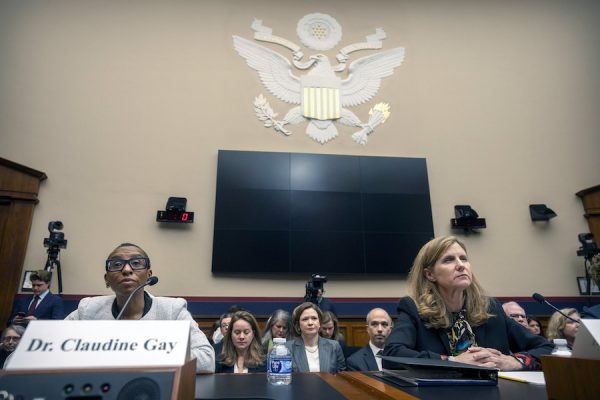For liberals, the end of the 2012–2013 Supreme Court term was the best of times and the worst of times.
The Supreme Court struck down the federal Defense of Marriage Act (DOMA) in United States v. Windsor and in Hollingsworth v. Perry left in place a district court decision requiring that California restore marriage equality.
But in Shelby County v. Holder, the Supreme Court struck down a key provision of the Voting Rights Act and in Fisher v. University of Texas, the Court instituted tighter scrutiny for race-conscious admissions policies in higher education. States immediately announced plans to revive restrictive election laws that the Voting Rights Act had previously blocked, including voter ID requirements.
The DOMA and Voting Rights Act cases have some important parallels beyond the fact that in both the Court struck down federal statutes. Section 3 of DOMA and Sections 4 and 5 of the Voting Rights Act each involved strong assertions of federal power in areas traditionally left to state regulation. Section 3 of DOMA created, for the first time, a federal definition of marriage that swept across more than 1,100 federal provisions. “Marriage” was restricted to “only a legal union between one man and one woman as husband and wife,” and the word “spouse” referred “only to a person of the opposite sex who is a husband or a wife.” Sections 4 and 5 of the Voting Rights Act created, for the first time, a requirement that certain states and jurisdictions—primarily, but not exclusively, in the South—obtain “preclearance”: federal approval before making any changes in their election laws.
In the marriage and voting rights cases, the world outside powerfully affected the court.
Put at a high enough level of abstraction, this federal assertiveness might explain judicial skepticism about each of these laws. As Chief Justice John Roberts observed in his opinion in the Affordable Care Act cases, while “there is a first time for everything,” sometimes “the most telling indication of [a] severe constitutional problem . . . is the lack of historical precedent for Congress’s action.”
Indeed, it is important to keep history in mind. The Voting Rights Act came at the end of a century of black disenfranchisement in spite of the requirements of the Fourteenth and Fifteenth Amendments. Finally, Congress took its responsibility to enforce those amendments seriously. And Congress’s later decisions to extend and amend the Act came after dozens of hearings and were based on thousands of pages of evidence.
By contrast, DOMA was passed hastily in 1996 before any state had granted legal recognition to same-sex couples. The purpose and effect of DOMA was to undercut state authority not in the service of pursuing a constitutional commitment to equality but in the service of cementing inequality.
So it was especially telling how the Court relied on ideals of equality in the two cases. In Windsor, the equality argument was straightforward. New York and other marriage-equality states had decided that same-sex couples were entitled to equality under the law. DOMA denied these couples the tangible equality and the equal status that came along with marriage as a matter of state law. One notable aspect of Justice Anthony Kennedy’s opinion for the Court was how often it used the word “dignity”—which appears nowhere in the Constitution—to describe the value at stake.
In Shelby County, on the other hand, Chief Justice Roberts’s opinion for the Court focused not on the value of political equality and dignity for minority citizens, but rather on the claim that the Constitution protects “equality” and “dignity” for the states: by treating states differently, the Voting Rights Act undercut this principle. In reaching that conclusion, he focused on the framing and on the Tenth Amendment but ignored entirely the historical context in which the Fourteenth and Fifteenth Amendments emerged.
Yet neither case was really about technical constitutional doctrine. In Windsor Justice Kennedy’s opinion never addressed the key doctrinal question of whether discrimination on the basis of sexual orientation should be subject to heightened scrutiny—that is, special judicial skepticism—as distinctions based on race or sex are. Similarly, Chief Justice Roberts’s opinion in Shelby County never even cites—let alone applies—the existing test for determining when an exercise of congressional power under the Fourteenth Amendment is “congruent and proportional” to the underlying problem.
Instead the same-sex marriage and voting rights cases are fundamentally about how constitutional principles interact with social conditions. At the oral argument in Hollingsworth v. Perry, Justice Antonin Scalia demanded to know when it had become “unconstitutional to exclude homosexual couples from marriage? 1791? 1868, when the Fourteenth Amendment was adopted?” Ted Olson, counsel for Perry, suggested that it became unconstitutional “when we as a culture determined” that sexual orientation should not trigger legal disabilities. Whereupon Justice Scalia asked again, “When did that happen?”
In one sense, the plaintiff in Windsor had a clear-cut answer to that question: DOMA was unconstitutional from the moment it was passed in 1996. The Supreme Court long before had held, “If the constitutional conception of ‘equal protection of the laws’ means anything, it must, at the very least, mean that a bare congressional desire to harm a politically unpopular group cannot constitute a legitimate governmental interest.” DOMA clearly flunks that test. But as a matter of legal realism, that answer is unsatisfying. It is very unlikely that the Court would have struck down DOMA in 1996. Society had first to change in ways that affected the justices every bit as much as it affected the two presidents—Clinton and Obama—who came to support marriage equality after their previous reservations.
Justice Scalia and the conservative majority had no trouble recognizing how changed social conditions might alter constitutional analysis in the Shelby County case. Chief Justice Roberts’s opinion for the Court held that although the Voting Rights Act had been a constitutionally appropriate response to the world of the 1960s, “Nearly 50 years later, things have changed dramatically.” Congress could therefore no longer rely on its understanding of the history, the voluminous evidence before it, and its members’ political expertise to conclude that there remained a danger of backsliding in the states and counties covered by the existing formula. The conservatives brushed aside Justice Ruth Bader Ginsburg’s insistence in dissent that a primary cause of that dramatic change was the Act itself and that Congress deserved deference when it concluded that “throwing out preclearance when it has worked and is continuing to work to stop discriminatory changes is like throwing away your umbrella in a rainstorm because you are not getting wet.”
The real challenge, then, is to understand whether and how the world has changed, and how those changes should inform constitutional interpretation. And here, it seems to me, is where the world outside the courts has most powerfully affected the decisions inside them. The LGBT equality movement has succeeded in the courts because it has gained widespread support from outside the gay community. It has convinced people of good will from across the political spectrum that homophobia exists, that it is wrong, and that constitutional law must respond to gay people’s claims for full inclusion in the key institutions of civic life.
By contrast, the civil rights movement has lately been far less successful in building popular consensus in favor of racial justice. Perhaps this is because the problems seem so much less tractable; it’s far easier to issue marriage licenses than to create good schools for all students. Perhaps this is because distributive justice seems like a zero-sum game, as people compete for scarce opportunities in higher education and employment. Perhaps this is because increased segregation and income inequality make it less likely that the powerful feel a connection to excluded minorities: they never wake up to discover their sons are black and poor.
As part of their work, liberals must rebuild the movement for racial justice so that principles of liberty and equality not only produce legislation that more fully realizes constitutional commitments, but also create a politics in which the Court too is more fully committed to these ideals.








